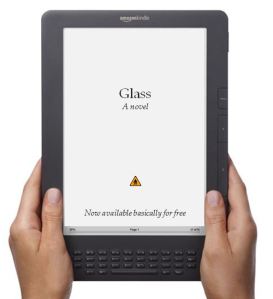 The Kindle is everywhere. In the weeks leading up to Christmas last year, Amazon boasted that they were selling over a million per week. The e-commerce giant has been “introducing” them on their homepage for so long that I’m beginning to wonder when might be a polite time to interject that we’ve already met. As I write this piece, my Amazon homepage introduces the Kindle Family: the Kindle, Kindle Touch and Kindle Touch 3G. Other customers are apparently also looking at the Kindle Keyboard 3G with Free 3G + Wi-Fi, the Kindle with Wi-Fi and 6″ E Ink Display, and Veet for Men Hair Removal Gel Crème. Something for everyone, then.
The Kindle is everywhere. In the weeks leading up to Christmas last year, Amazon boasted that they were selling over a million per week. The e-commerce giant has been “introducing” them on their homepage for so long that I’m beginning to wonder when might be a polite time to interject that we’ve already met. As I write this piece, my Amazon homepage introduces the Kindle Family: the Kindle, Kindle Touch and Kindle Touch 3G. Other customers are apparently also looking at the Kindle Keyboard 3G with Free 3G + Wi-Fi, the Kindle with Wi-Fi and 6″ E Ink Display, and Veet for Men Hair Removal Gel Crème. Something for everyone, then.
Amazon was founded as a bookseller, but it became more successful than any of its competitors because it removed something previously thought of as crucial to bookselling, which was the bookshop. Instead they posted your book directly from their warehouse, which you could then open like a little present in the comfort of your own home.
For Amazon’s next trick, they removed an element which many regarded as a defining feature of the book, namely the codex itself. With ebook technology available but no one else willing to invest in developing the market, Amazon was like a (very businesslike and non-violent) wolf among sheep. Both heavy investment in the technology of their own-brand Kindle device and its unbeatable retail price gave them a de facto monopoly, particularly in Britain, where the competitive Nook isn’t being sold.
Now, it looks as if they are putting the infrastructure in place to make another seismic shift—from ownership to access. As well as Amazon Cloud Drive which, like Apple’s iCloud, lets you store the files you’ve bought securely online, they have created the Lending Library—a name which evokes nostalgic, homely images. They already have over 100,000 books on their digital shelves, and if you’re part of the scheme you can borrow one a month, with no overdue charges and no need to worry about whether you’ll have to join a three year waiting list to borrow the latest Game of Thrones.
The catch is that, unlike your friendly local library, it is not available for all comers. At the moment you have to be a US customer, and you also have to be subscribed to their Amazon Prime service, which will set you back $79 a year. If you do borrow a book by George RR Martin, he will get a tiny royalty. So you pay a flat subscription rate for access to content, and the owner of the intellectual property gets a smaller royalty than if you had bought it, because you never own the content. The Lending Library is beginning to look like a very familiar revenue model, one that is tremendously lucrative for the owner of the service, and less so for the owners of the content.
Except—and this is why I feel a vague sense of unease every time I land on the Amazon homepage—to qualify for the Lending Library, you have to be a Kindle device owner. At least Spotify have never tried to force you to buy a Spotify mp3 device. If I were the suspicious type, I might start to worry that, with its virtual monopoly on the ebook market, Amazon was trying to funnel my consumer behaviour into ever more proprietorial systems, designed to make owning and sharing harder and more expensive than if, for instance, I just went back to where it all started, and bought a physical book.
No-one has sold more physical or electronic books than Amazon in the past decade. For that, they have done the world a great service. But where musicians have tried to make up for declining record sales by making money from live music, authors have no direct analogue. So if Amazon loves books, I hope it remembers its roots and continues to sell them, because this isn’t quite the replacement for our local libraries that I had envisioned.